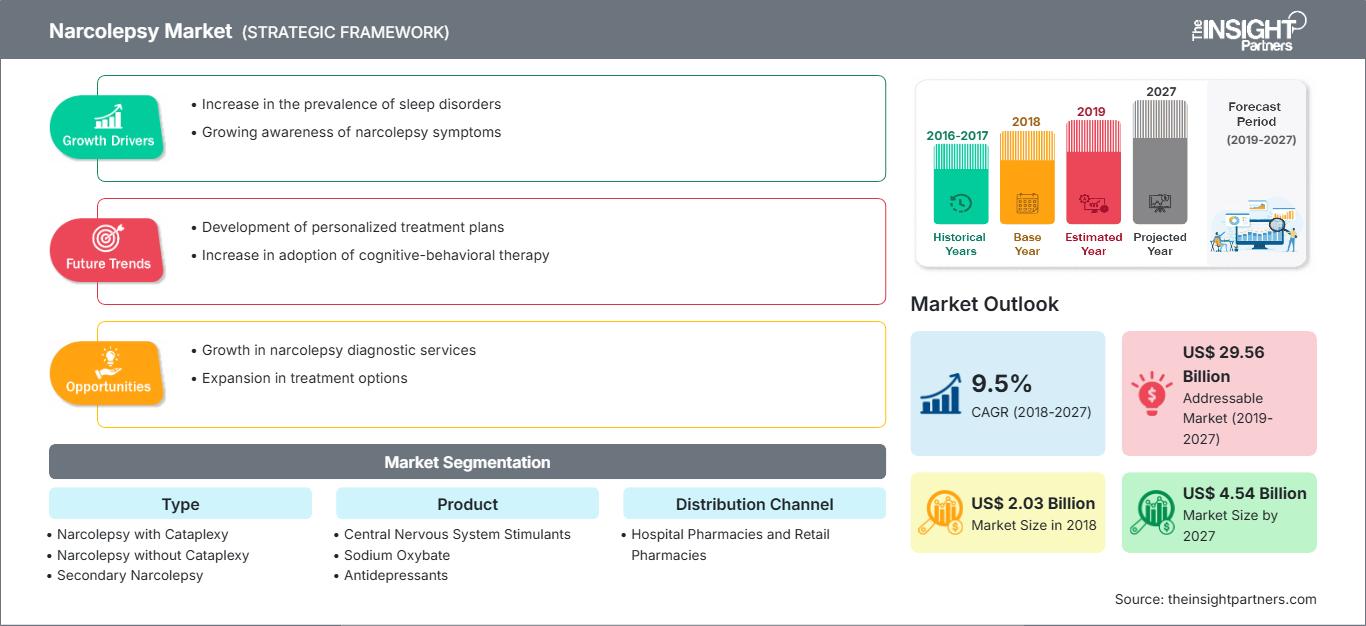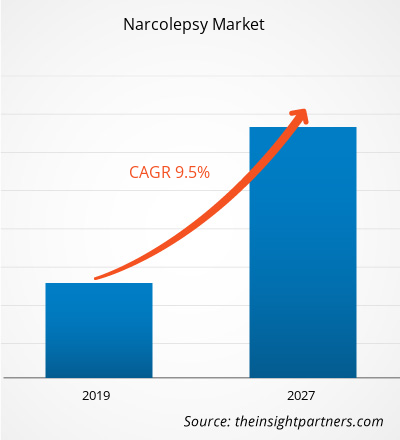Der Markt für Narkolepsie wird voraussichtlich von 2.026,8 Millionen US-Dollar im Jahr 2018 auf 4.537,9 Millionen US-Dollar im Jahr 2027 anwachsen; für den Zeitraum 2019–2027 wird ein jährliches Wachstum von 9,5 % erwartet.
Narkolepsie ist eine seltene, langfristige Hirnerkrankung, die bei bestimmten Patienten durch übermäßige Schläfrigkeit, Schlaflähmung, Halluzinationen und Kataplexie-Episoden gekennzeichnet ist. Narkolepsie tritt bekanntermaßen bei Männern und Frauen gleichermaßen auf, und die weltweite Inzidenz von Narkolepsie wird auf etwa 1 von 2.000 Menschen geschätzt. Menschen mit Narkolepsie fühlen sich tagsüber sehr schläfrig und können bei normalen Aktivitäten unwillkürlich einschlafen. Darüber hinaus ist Narkolepsie durch übermäßige Schläfrigkeit und Schlafepisoden gekennzeichnet. Narkolepsie erschwert es Betroffenen, längere Zeit wach zu bleiben, und führt dazu, dass sie den größten Teil des Tages schläfrig sind. Das Wachstum des Narkolepsie-Marktes wird auf die zunehmende Verbreitung schlafbezogener neurologischer Störungen, die Gründung lokaler Pharma- und Biopharmaunternehmen und das zunehmende Bewusstsein für neurologische Störungen zurückgeführt. Nebenwirkungen und Risiken der Narkolepsie-Medikamente sowie verzögerte und Fehldiagnosen der Krankheit dürften sich jedoch negativ auf das Wachstum des Narkolepsie-Marktes auswirken.
Passen Sie diesen Bericht Ihren Anforderungen an
Sie erhalten kostenlos Anpassungen an jedem Bericht, einschließlich Teilen dieses Berichts oder einer Analyse auf Länderebene, eines Excel-Datenpakets sowie tolle Angebote und Rabatte für Start-ups und Universitäten.
Narkolepsie-Markt: Strategische Einblicke

-
Holen Sie sich die wichtigsten Markttrends aus diesem Bericht.Dieses KOSTENLOSE Beispiel umfasst Datenanalysen, die von Markttrends bis hin zu Schätzungen und Prognosen reichen.
Markteinblicke: Steigende Prävalenz schlafbezogener neurologischer Störungen treibt den Narkolepsie-Markt an
Das Spektrum der von Neurologen behandelten Schlafstörungen ist breit und umfasst Erkrankungen wie Schlaflosigkeit, Schlafapnoe, Restless-Legs-Syndrom und Narkolepsie. Diese Störungen verursachen Störungen des normalen Schlaf-Wach-Mechanismus und verursachen endogene Anomalien. Es wird erwartet, dass neurologische schlafbezogene Störungen in den kommenden Jahren zunehmen werden, da ein großer Teil der Bevölkerung ins hohe Alter kommt. Laut dem National Institute of Health (NIH) leiden in den USA etwa 40 Millionen Amerikaner an neurologischen Erkrankungen und 20 Millionen Menschen haben gelegentlich Schlafprobleme. In den letzten Jahrzehnten hat man viel über die Pathophysiologie der Narkolepsie gelernt. Laut dem National Center for Biotechnology Information wurde die Prävalenz von Narkolepsie mit Kataplexie in vielen Studien untersucht und liegt zwischen 25 und 50 pro 100.000 Menschen. Laut dem Narcolepsy Network 2017 betrifft die Krankheit zudem 1 von 2.000 Menschen in den USA, d. h. 200.000 Amerikaner und etwa 3 Millionen weltweit. Darüber hinaus berichtet die American Sleep Apnea Association, dass 50 bis 70 Millionen Amerikaner aller Altersgruppen und sozioökonomischen Schichten von schlafbezogenen Problemen betroffen sind. Allerdings wurden bei Minderheiten und unterversorgten Bevölkerungsgruppen erhebliche Unterschiede bei der Prävalenz und Schwere bestimmter Schlafstörungen festgestellt. Über 50 Millionen Amerikaner leiden bereits an über 80 verschiedenen Schlafstörungen und weitere 20 bis 30 Millionen leiden jedes Jahr an intermittierenden Schlafproblemen. Menschen mit Narkolepsie leiden unter chronischer Tagesmüdigkeit und Episoden, in denen sie tagsüber unerwartet einschlafen. Diese „Schlafattacken“ können jederzeit und bei jeder Aktivität auftreten. Sie beschränken sich nicht auf Phasen mit eintöniger oder wenig aktiver Aktivität, sondern können auch während der Schul- oder Arbeitszeit, mitten in einem Gespräch, beim Essen, beim Sport oder sogar beim Autofahren auftreten. Daher wird der Anstieg schlafbezogener neurologischer Störungen die Entwicklung des Narkolepsiemarktes im Prognosezeitraum voraussichtlich vorantreiben.
Typbasierte Erkenntnisse
Der globale Narkolepsiemarkt ist nach Typ segmentiert in Narkolepsie mit Kataplexie, Narkolepsie ohne Kataplexie und sekundäre Narkolepsie. Das Segment Narkolepsie mit Kataplexie hatte 2018 den größten Anteil unter den Typ-Untersegmenten des Narkolepsiemarktes und dürfte im Prognosezeitraum einen ähnlichen Trend aufweisen. Narkolepsie mit Kataplexie, auch Narkolepsie Typ 1 genannt, ist eine seltene neurologische Erkrankung, die aufgrund eines niedrigen Hypocretinspiegels oder berichteter Kataplexie-Ereignisse diagnostiziert wird. Kataplexie bezeichnet eine plötzliche und unkontrollierbare Muskelschwäche oder -lähmung, die hauptsächlich tagsüber auftritt und oft durch starke Emotionen wie Aufregung oder Lachen ausgelöst wird. Die betroffene Person verliert ihren Muskeltonus und kann ohne große Vorwarnung einen schlaffen Kiefer, gebrochene Sprache, krumme Knie oder völlige Schwäche in Gesicht, Armen, Beinen und Rumpf entwickeln. Der Verlust des Muskeltonus bei Kataplexie entsteht durch die Unfähigkeit, Schlaf- und Wachzustände zu regulieren. In etwa 10 % der Fälle von Narkolepsie ist Kataplexie das erste Symptom, das auftritt, und kann fälschlicherweise als Anfallsleiden diagnostiziert werden.
Produktbasierte Erkenntnisse
Der globale Narkolepsiemarkt ist, basierend auf dem Produkt, in Stimulanzien des zentralen Nervensystems (ZNS), Natriumoxybat und Antidepressiva segmentiert. Das Segment Natriumoxybat hatte 2018 den größten Marktanteil bei Narkolepsie. Natriumoxybat, auch bekannt als Gamma-Hydroxybutyrat (GHB), ist dafür bekannt, Tagesmüdigkeit und Kataplexie zu reduzieren, indem es den Nachtschlaf von Patienten mit Narkolepsie verbessert. GHB wird zur Behandlung von Narkolepsie verwendet, einer Erkrankung, die starke Tagesmüdigkeit verursacht. Natriumoxybat kann die Tagesmüdigkeit verringern und auch die Anzahl plötzlicher kurzer Anfälle schwacher/gelähmter Muskeln (bekannt als Kataplexie) reduzieren, die bei Patienten mit Narkolepsie auftreten können. Dieses Medikament ist hochwirksam bei Kataplexie. Natriumoxybat hilft, den nächtlichen Schlaf zu verbessern, der bei Narkolepsie oft schlecht ist. In hohen Dosen kann es auch helfen, die Tagesmüdigkeit zu kontrollieren. Es muss in zwei Dosen eingenommen werden, eine vor dem Schlafengehen und eine bis zu vier Stunden später.
Einblicke auf der Grundlage von Vertriebskanälen
Der globale Narkolepsiemarkt ist basierend auf den Vertriebskanälen in Krankenhausapotheken und Einzelhandelsapotheken unterteilt. Das Segment der Krankenhausapotheken war 2018 führend auf dem Narkolepsiemarkt. Krankenhausapotheken beziehen sich auf die medizinischen Apotheken, die sich in der Regel auf dem Krankenhausgelände befinden. Diese Apotheken führen eine große Anzahl von Medikamenten, darunter hauptsächlich Spezial- und Prüfpräparate. Krankenhausapotheken stellen Medikamente in der Regel nur für stationäre Patienten bereit und sind keine Einzelhandelsgeschäfte. Krankenhausapotheken können täglich eine große Menge an Medikamenten bereitstellen, die den Stationen und Intensivstationen entsprechend dem Medikamentenplan des Patienten zugeteilt werden. Größere Krankenhäuser können automatisierte Transportsysteme nutzen, um die effiziente Verteilung von Medikamenten zu unterstützen.
Narkolepsie
Regionale Einblicke in den Narkolepsie-MarktDie Analysten von The Insight Partners haben die regionalen Trends und Faktoren, die den Narkolepsiemarkt im Prognosezeitraum beeinflussen, ausführlich erläutert. In diesem Abschnitt werden auch die Marktsegmente und die geografische Lage in Nordamerika, Europa, dem asiatisch-pazifischen Raum, dem Nahen Osten und Afrika sowie Süd- und Mittelamerika erörtert.
Umfang des Marktberichts zur Narkolepsie
| Berichtsattribut | Einzelheiten |
|---|---|
| Marktgröße in 2018 | US$ 2.03 Billion |
| Marktgröße nach 2027 | US$ 4.54 Billion |
| Globale CAGR (2018 - 2027) | 9.5% |
| Historische Daten | 2016-2017 |
| Prognosezeitraum | 2019-2027 |
| Abgedeckte Segmente |
By Typ
|
| Abgedeckte Regionen und Länder |
Nordamerika
|
| Marktführer und wichtige Unternehmensprofile |
|
Dichte der Marktteilnehmer im Bereich Narkolepsie: Verständnis ihrer Auswirkungen auf die Geschäftsdynamik
Der Narkolepsiemarkt wächst rasant, angetrieben durch die steigende Endverbrauchernachfrage aufgrund von Faktoren wie sich entwickelnden Verbraucherpräferenzen, technologischem Fortschritt und einem stärkeren Bewusstsein für die Produktvorteile. Mit steigender Nachfrage erweitern Unternehmen ihr Angebot, entwickeln Innovationen, um den Verbraucherbedürfnissen gerecht zu werden, und nutzen neue Trends, was das Marktwachstum weiter ankurbelt.

- Holen Sie sich die Narkolepsie-Markt Übersicht der wichtigsten Akteure
Produkteinführungen und -zulassungen sind gängige Strategien von Unternehmen, um ihre globale Präsenz und ihr Produktportfolio zu erweitern. Darüber hinaus setzen die Akteure auf Partnerschaftsstrategien, um ihren Kundenstamm zu erweitern und so ihren Markennamen weltweit zu behaupten. Es wird erwartet, dass der Marktanteil durch die Entwicklung neuer innovativer Produkte durch die Marktteilnehmer floriert. Zu den Marktteilnehmern, die Produkte anbieten, gehören Teva Pharmaceutical Industries Ltd; Jazz Pharmaceuticals plc; Arena Pharmaceuticals, Inc; Graymark Healthcare, Inc; Novartis AG; Takeda Pharmaceutical Company Limited; Mylan NV; BIOPROJET; Shionogi & Co., Ltd; und Ligand Pharmaceuticals, Inc.
- Historische Analyse (2 Jahre), Basisjahr, Prognose (7 Jahre) mit CAGR
- PEST- und SWOT-Analyse
- Marktgröße Wert/Volumen – Global, Regional, Land
- Branchen- und Wettbewerbslandschaft
- Excel-Datensatz
Aktuelle Berichte
Erfahrungsberichte
Grund zum Kauf
- Fundierte Entscheidungsfindung
- Marktdynamik verstehen
- Wettbewerbsanalyse
- Kundeneinblicke
- Marktprognosen
- Risikominimierung
- Strategische Planung
- Investitionsbegründung
- Identifizierung neuer Märkte
- Verbesserung von Marketingstrategien
- Steigerung der Betriebseffizienz
- Anpassung an regulatorische Trends






















 Kostenlose Probe anfordern für - Narkolepsie-Markt
Kostenlose Probe anfordern für - Narkolepsie-Markt